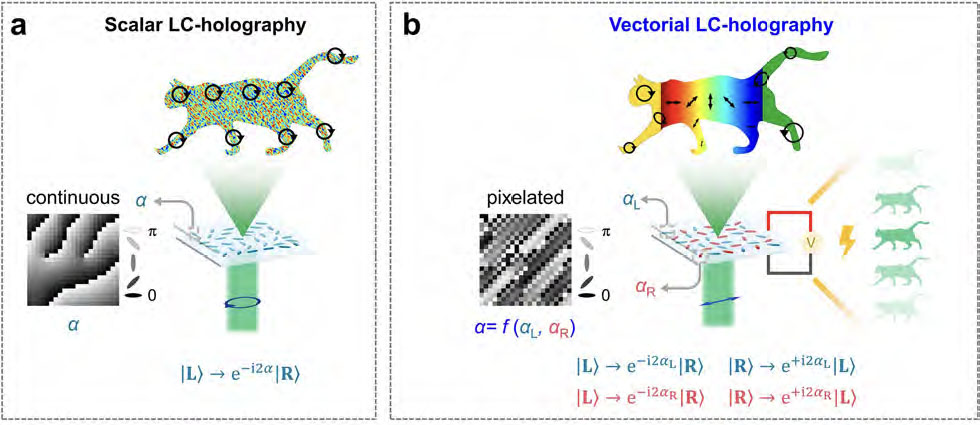| Mar 11, 2024 |
|
|
|
(Nanowerk Spotlight) Holography, the technique of using light to reconstruct three-dimensional images, has long captured the imagination of scientists and the public alike. By recording and later recreating the complete waveform of light reflected off an object, holograms can display images that shift and change perspective based on the viewer’s position, creating a compelling illusion of depth. The dream of leveraging this capability to create dynamic, full-color holographic displays has driven decades of research but has remained stubbornly out of reach.
|
|
The challenge lies in the fact that, to create a hologram, light waves must be precisely controlled at scales smaller than the wavelength of light itself. Traditional holography relies on using films of light-sensitive materials to record interference patterns, which in turn can reproduce the light wavefront and create a holographic image.
|
|
However, this approach produces static holograms that cannot be easily changed. More recently, scientists have experimented with using liquid crystals, materials in which rod-shaped molecules self-align into ordered structures, as dynamic holographic media. Applying electric fields can change the orientation of liquid crystal molecules, altering how they interact with light and potentially allowing the holographic image to be tuned.
|
|
Until now, however, liquid crystal-based holography has faced limitations. Most approaches layer liquid crystals on top of static patterned surfaces or metasurfaces designed to change the phase of light waves in specific ways. While these hybrid liquid crystal-metasurface systems provide some tunability, they are complex to fabricate, and the liquid crystal layer can typically only impart uniform changes to the pre-defined phase pattern. This constrains image generation and prevents projecting completely arbitrary holographic images. Creating a liquid crystal system capable of versatile and dynamic holography has remained an unmet need.
|
|
That is, until a groundbreaking new study from a research team spanning three universities in China and Singapore. As reported in the journal eLight (“Vectorial liquid‑crystal holography”), the scientists have developed the first single-layer liquid crystal device able to generate completely arbitrary dynamic holographic images encompassing the full visible color spectrum. Their new approach, which they dub “vectorial holography,” has the potential to finally enable practical holographic displays.
|
 |
| Schematic illustrations of scalar and vectorial LC-holography. a Scalar LC-holography. Holographic image (a cat) is reconstructed with a random phase distribution when illuminated by LCP light. b Vectorial LC-holography. We spatially multiplexing the LC holograms for LCP and RCP into a single LC layer, which are indicated by blue and red LC directors. Two independent holographic images (a cat without a tail and a cat without a head) are generated with spatially variant amplitudes and phase differences when illuminated by linearly polarized light. These two images are partially overlapped. The vectorial pattern is determined by both the phase difference distribution and amplitude ratio. eLight, (CC BY 4.0)
|
|
The key to the team’s innovation was developing a way to take complete control over liquid crystal molecules on a pixel-by-pixel basis within a single layer. They achieved this by using a digital micromirror device as a dynamic photomask, allowing them to precisely define the molecular orientation at over a million points across the liquid crystal layer with a resolution of approximately one micrometer. By simultaneously controlling the orientation angle and the resultant phase shift imparted at each pixel when a voltage is applied, the researchers could holographically define a target light field with complete control over both the amplitude and polarization of the wavefront at every point.
|
|
Using this approach, the scientists were able to generate two fully independent holographic images, one for left circularly polarized light and one for right circularly polarized light. They then ingeniously combined these two images into a single liquid crystal pattern using a newly developed hologram-calculation algorithm. When illuminated with light of either polarization, this combined hologram produces the target image for that handedness on one side, but with an equal and opposite phase shift between the two. Thus, the polarization of light is transformed in a defined way at every point in the outgoing wavefront.
|
|
By using input light containing an equal mix of both circular polarizations, the researchers could make the two holographic images interfere, effectively giving them pixel-level control over the resulting polarization at every point – including the ability to create points of linear polarization at any angle. The amplitude and phase relationship between the two circular polarizations defines a polarization state that traces out a path on the Poincaré sphere, a graphical representation of all possible polarizations, as the hologram is traversed.
|
|
Using this polarization control as an additional degree of freedom, the team demonstrated several remarkable capabilities. They created a holographic image of a clock in which the hour and minute hands were projected with opposite circular polarizations while numbers were encoded as specific linear polarizations at different angles, encrypting the full time in a way only revealed through polarization analysis. Even more strikingly, they generated holographic images of the moon in which both the spatially varying amplitude and polarization were simultaneously controlled in an entirely arbitrary manner.
|
|
By applying an electric field, the scientists could tune and switch these holographic projections in real-time, thanks to the dynamic response of the liquid crystal molecules. They even created a holographic video of a football player taking a free kick, in which different temporal frames were multiplexed in the linear polarization channels and could be viewed in sequence by rotating a polarization analyzer. The entire system proved highly efficient, with over 60% of input light being converted into the desired holographic wavefront across the whole visible spectrum – a key advance over the narrow-band nature of metasurface-based approaches.
|
|
With this groundbreaking work, the researchers have opened up an entirely new paradigm for liquid crystal holography. Their polarization multiplexing approach exponentially expands the information capacity of holograms and allows complete control over reconstructed light fields. The simplicity of their single-layer design combined with the rapid response and broadband capability of liquid crystals makes their platform uniquely suited for creating dynamic holographic displays. Real-time, full-color holographic video is now within reach.
|
|
Looking ahead, the researchers envision a wide range of applications for their vectorial holography technology. Encrypted holographic images could be used as a versatile new platform for security and anti-counterfeiting. Holographic projections could enable new augmented and virtual reality displays. The arbitrary control of both light’s amplitude and polarization may enable novel types of optical traps and manipulations for biological research and nano-assembly. As the team refines their fabrication process and scales up the size of their liquid crystal holograms, these and many more possibilities are poised to become reality.
|
|
The development of the first single-layer liquid crystal device capable of complete dynamic control over holographic light fields is unquestionably a landmark achievement. By fully leveraging the liquid nature of liquid crystals and combining amplitude and polarization control in a unified framework, the researchers have achieved what was previously thought impossible with liquid crystal holography. As research into this new technique continues and further integrates breakthroughs in materials science and optical engineering, the long-held sci-fi dream of real-time, full-color holographic displays for communication, entertainment, education and scientific visualization may finally be within our grasp.
|
|

By
Michael
Berger
– Michael is author of three books by the Royal Society of Chemistry:
Nano-Society: Pushing the Boundaries of Technology,
Nanotechnology: The Future is Tiny, and
Nanoengineering: The Skills and Tools Making Technology Invisible
Copyright ©
Nanowerk LLC
|
|
|
- SEO Powered Content & PR Distribution. Get Amplified Today.
- PlatoData.Network Vertical Generative Ai. Empower Yourself. Access Here.
- PlatoAiStream. Web3 Intelligence. Knowledge Amplified. Access Here.
- PlatoESG. Carbon, CleanTech, Energy, Environment, Solar, Waste Management. Access Here.
- PlatoHealth. Biotech and Clinical Trials Intelligence. Access Here.
- Source: https://www.nanowerk.com/spotlight/spotid=64826.php





